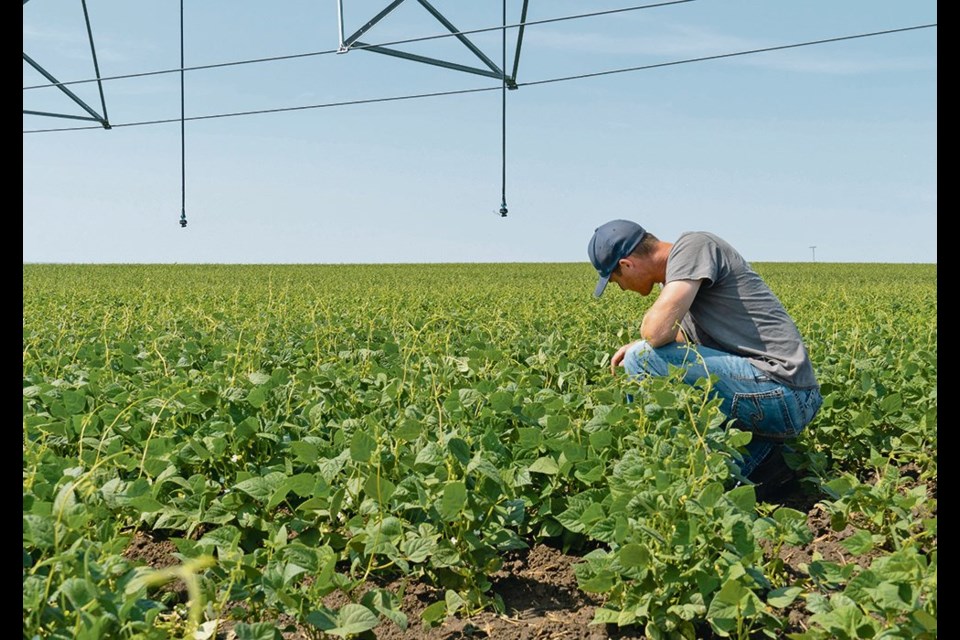RIVERHURST — The drought of 2021 showcased the benefits of irrigation farming in a big way, says Jeff Ewen.
He operates a 12,000-acre grain farm with his father and two brothers near Riverhurst, Sask. One-quarter of their land is irrigated.
Irrigated durum yields averaged between 90 and 110 bushels per acre last year on the E3 Ag Ventures farm compared to 10 to 15 for dryland durum.
Their irrigated canola delivered yields of 60 to 70 bu. per acre compared to 10 to 15 for dryland.
“When it’s extremely dry it really shows the true potential of water and how valuable water is in central and southern Saskatchewan,” said Jeff.
He thinks of it as an expensive insurance policy for the farm and is thankful they have that rare risk management option.
“We’re just lucky that we own land along Lake Diefenbaker,” he said.
“Obviously, we’re very fortunate compared to others who are 100 percent dryland farmers.”
The operation used to be a strictly dryland farm situated just outside the boundaries of an irrigation district.
About 15 years ago they had the opportunity to purchase five quarters within the district and that was the start of a doubling in the size of the farm.
It created the opportunity for the boys to come back to the farm and earn a living.
The family has since rented 10 more quarters of irrigated land and have had the chance to convert some of their own land to irrigated acres when the district expanded. They now operate 22 centre pivots.
They eventually settled on an irrigation rotation of dry edible beans, canola, flax and a cereal crop, which is often durum. The rotation works well for their fertilization requirements and other agronomy needs.
They have contemplated growing higher value crops like potatoes and onions but Jeff said there needs to be more processing infrastructure and extension programming before they go down that road.
Jeff graduated with a bachelor of agriculture degree from the University of Saskatchewan in 2012.
He spent five years working as an irrigation agrologist with Saskatchewan Agriculture in Outlook, Sask., before becoming a full-time farmer.
Jeff is vice-chair of the Irrigation Crop Diversification Corp., a non-profit organization that field-tests ideas coming from irrigators, industry and researchers.
His wife, Riley Ewen, grew up on a mixed farm near Eyebrow, Sask. They went to the same high school in Central Butte, Sask.
She works as a nurse in Moose Jaw. The job is casual hours, which is good because the couple have two daughters — 10-month-old Ava and three-year-old Harper.
“It is hard for me to go and work as a nurse an hour away when we’ve got such young kids,” she said.
Riley is at a point where she can see herself putting her nursing career on the backburner while the kids are growing up and taking on an active role as an administrator of the farm business.
She has noticed that irrigation farming is a little different than regular grain farming.
“It’s more work. There is no real break in summer. On other farms it’s very seasonal but I find with the irrigation farm it’s a lot less seasonal,” said Riley.
As soon as the crop is in the ground Jeff is busy managing and maintaining the pivots. There is not much down-time.
“But at least we live right by the lake, so when I can get him away from work, we can easily go and enjoy ourselves,” she said.
“We’re literally like five minutes from the marina, so we can take (the girls) out pretty easily for short trips out on the lake.”
The lake provided between 254 and 355 millimetres of water to their irrigated crops last summer.
That was an exceptional year. The crops usually require 152 to 203 mm in a typical growing season. In a wet year, they may only need 50 mm.
The water is free, but they must pay their share of the infrastructure and electrical bill for the central pumping system plus their own electrical and infrastructure costs.
They pay for up to 305 mm of water per year. Anything beyond that costs extra.
The total bill works out to about $80 per acre because they have a “Cadillac” system. Irrigators who use canal systems instead of pipelines can pay as little as half that amount.
Jeff hopes to expand their irrigated acres. The province recently announced the Lake Diefenbaker Irrigation Expansion Project, a $4 billion initiative aimed at creating 500,000 acres of new irrigable land.
Unfortunately, that project won’t likely have a big impact on E3 Ag Ventures but it is creating a lot of excitement in the local farm community.
Jeff is eager to diversify their operation. They recently ventured into the dry bean seed production business.
Riley is happy that her husband is enthusiastic about growing the business. She hopes the expansion will soon result in a role for her and eventually for two other important family members.
“It just makes me so proud to see him growing it and our daughters will have that legacy for them,” she said.

